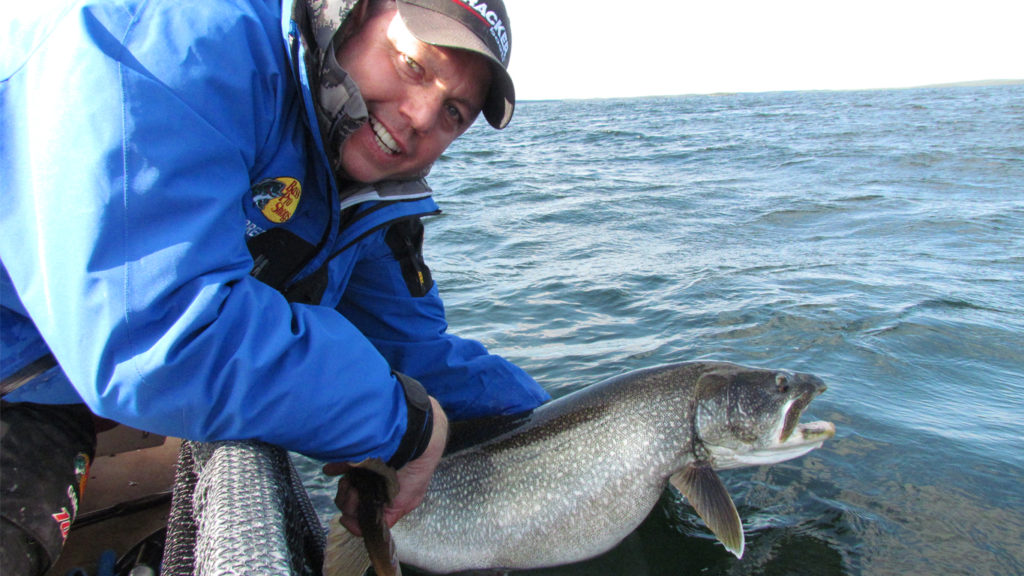Three-Way Rigging Lake Trout
Lake trout are considered by many anglers to be one of the strangest fighting freshwater fish species throughout North America. If you’ve had the good fortune of setting your hook into a large lake trout than you have a good understanding of what avid lake trout anglers are talking about. Lake trout will test an angler’s patience, stamina, gear, and fishing ability, during any given hookup. In large waterbodies, a lake trout’s size will range from fingerling, all the way up to the current International Game Fish Association’s world record of 72-pounds caught in August 1995, in Great Bear Lake, in the Northwest Territories, Canada. I’ve had the good fortune of fishing several lakes in the Northwest Territories, and I personally believe the next world record lake trout will come out of Nonacho Lake, Northwest Territories.
Lake trout are a native fish species to the northern portion of North America, most common in the northeastern United States, Canada, Alaska, and have successfully been introduced into a wide variety of non-native waterbodies throughout North America for conservation efforts and to increase angling opportunities. Lake trout inhabit large, deep, and cold oxygen-rich waterbodies and will not only live but thrive at depths ranging from 50 to over 200 feet of water. Many avid lake trout anglers target deep lake trout using down-riggers which allows the angler to keep their bait on the bottom or at a desired depth as they troll their presentation looking for active feeding fish. Like any fish species, to consistently trigger bites from lake trout, your bait needs to be in the strike zone. However, how do you consistently do that if you don’t have down-riggers?
Trolling Three-Way Rigs
Often referred to as a poor man’s down rigging, a three-way rig is simply a three-way swivel acting as an intersection. The mainline from your rod and reel is the first connection at the (top) of the three-way swivel. On the second position of the swivel (middle) is the line that is tied to your bait and runs horizontal (when trolled) to your mainline. The third line ties to the (bottom) portion of the three-way and runs vertical to the mainline and secures a large ball-weight that will get your bait down to the desired depth. However, the real key to the three-way system is a good quality line counter reel. Your sonar and line counter reel are your eyes to accurately fishing the depth the fish are holding at. For example, if I’m fishing in 100-feet of water and the fish are holding at 80-feet, I will let out enough line, taking in account speed, line, and lure drag, to run my presentation at 78 to 82-feet of water so I’m consistently trolling my lure in the strike zone. Each time you get a hit take note of the depth and speed your presentation was running and repeat both speed and depth.
You want the fish to exert the least amount of effort to take your offering. I believe with any fish species if they don’t have to work hard for a meal they will feed even if they’re in a negative feeding pattern. The three-way works similar to a downrigger, however, it’s more hands-on. Anglers can easily adjust the depth of their lure by reeling in or releasing line using their line counter reel. This method can be just as effective as downriggers when fished correctly.

Trolling Three-Way Rigs and setup
Rod: Bass Pro Shops Power Plus Trophy Class 7’ 6” Medium Heavy action rod.
Reel: Abu Garcia Ambassadeur line counter 5500LC or 6500LC reel with a 5.3:1 gear ratio.
Line: Bass Pro Shops Hyper Braid 30lb or 40lb line and spool on 300 yards or better.
Three-Way Swivel: Bass Pro Shops Three-Way Swivel size# 1/0.
Bait line: 30lb monofilament 3-feet in length with a Bass Pro Shops Barrel Swivel with interlock size# 1/0 tied to both ends of the line for easy bait changeout.
Ball-weight Line: 12-inches 30lb monofilament.
Bullet Weights 8 to 10 oz.
My favorite bait is a #4 Len Thompson lure in the red and white or 5 of Diamonds color pattern.
Three-way trolling methods will work on suspended lake trout that are holding at deeper depths within the water column or lake trout resting right on the bottom. Trolling a three-way rig system is an inexpensive way to cover deep water and get your bait in front of active feeding lake trout.
